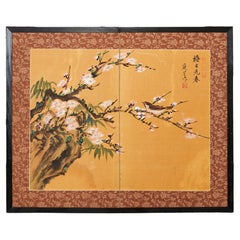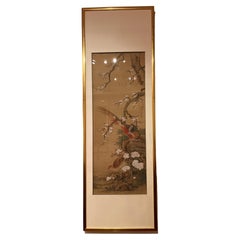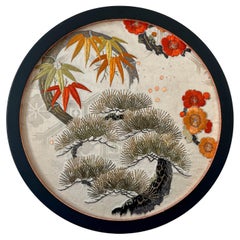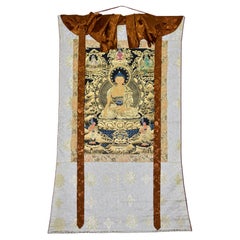Asian Paintings and Screens
to
285
923
319
1,489
103
9
41
26
16
4
4
2
2
164
603
722
112
284
149
68
36
4
30
13
6
16
19
19
7
2
714
672
616
518
427
1,601
1,429
924
449
135
1,601
1,560
1,574
29
4
3
3
2
Place of Origin: Asian
Asian Two Panel Table Screen Flowering Prunus with Songbird
Located in Rio Vista, CA
Colorful Asian two panel byobu screen featuring a blossoming prunus tree with a songbird perched on its branch. Vibrant ink and color pigments applied to a golden silk ground. The pa...
Category
20th Century Chinese Export Asian Paintings and Screens
Materials
Brass
Fine Asian Brush Painting of Pheasant and Quail
Located in Greenwich, CT
Fined Chinese brush painting of a pheasant and a quail under a plum tree, ink and color on silk, 19th century, Conservation framed
Painting was a scroll acquired from Sotheby's webs...
Category
Late 19th Century Qing Antique Asian Paintings and Screens
Materials
Silk
18th Century Nagasaki School Tiger Screen
Located in Fukuoka, JP
18th Century Nagasaki School Tiger Screen
Period: Edo
Size: 165 x 172 cm (65 x 67.7 inches)
SKU: PTA69
This exceptional 18th-century screen from the Edo...
Category
Early 18th Century Edo Antique Asian Paintings and Screens
Materials
Wood, Paper
Antique obi textile art " View from the Window ~ Shochikubai ~ " by ikasu, Japan
By Kimono ikasu
Located in Setagaya City, JP
This work is a glorious nod to buddhist temples circle windows, with beautiful Japanese garden scape seen outside. Golden leaf on the border of a frame is an expression of light goin...
Category
1910s Japonisme Vintage Asian Paintings and Screens
Materials
Gold Leaf
Hand Painted Tibetan Thangka Painting Buddha Shakyamuni White Gold
Located in Somis, CA
An exquisitely hand painted Tibetan Thangka by one of our master artists in Nepal featuring Buddha Shakyamuni. On lotus throne above ocean waves and an altar bowl overflowing with fl...
Category
2010s Tibetan Asian Paintings and Screens
Materials
Brocade, Wood, Paint
$750 Sale Price
51% Off
Artisan's Cache of 25 Old Chinese Paint Calligraphy Bamboo Brushes
Located in South Burlington, VT
Here's a rare find from a collector we visited in Japan. A very unusual treasure....
This is a cache of old Chinese and Japanese bamboo paint and calligraphy artist brushes dating ...
Category
Mid-20th Century Showa Asian Paintings and Screens
Materials
Bamboo
$156 Sale Price
20% Off
Antique Tibetan Hand Painted Silk and Canvas Thangka with Figures C1920
Located in Big Flats, NY
Antique Tibetan Hand Painted Silk and Canvas Thangka with Figures C1920
Measures- 33.25''H x 25''W x .25''D
Category
Early 20th Century Tibetan Asian Paintings and Screens
Materials
Canvas, Silk, Paint
$760 Sale Price
20% Off
Pair of Japanese Edo Screens Minogame Turtles in Spring Landscape
Located in Rio Vista, CA
Colorful pair of 19th century Japanese Edo period six-panel byobu table screens depicting pairs of Minogame turtles in spring landscapes. Made in the Kano school style one screen...
Category
19th Century Edo Antique Asian Paintings and Screens
Materials
Brass
Vintage Pichhavai Painting of Krishna and Gopis, Gouache on Silk Rajasthan India
Located in North Hollywood, CA
Vintage Pichhavai Painting of Krishna and Gopis, Gouache & Gold on Cloth, Rajasthan
Vibrant Indian miniature painting in the Pichhavai style depicting Krishna’s Raas Leela with Radha...
Category
Mid-20th Century Anglo-Indian Asian Paintings and Screens
Materials
Silk
Two-panel screen
By Japanese Studio
Located in Brescia, IT
Modern two-panel screen with white peonies.
Hand-painted on vegetable paper.
Very fresh work that is easy to incorporate into design furniture.
Very good state of preservation, sig...
Category
20th Century Showa Asian Paintings and Screens
Materials
Wood, Paper
$3,537
Paravento Giapponese a due pannelli
By Japanese Studio
Located in Brescia, IT
Sempre alla ricerca di cose particolari abbiamo acquistato questo paravento giapponese da una collezionista di Osaka.
Un esempio di arte del novec...
Category
20th Century Showa Asian Paintings and Screens
Materials
Gold
Pair of Japanese Screens: Ink paintings of peacocks on gold leaf by Imao Keinen
By Imao Keinen
Located in Prahran, Victoria
A pair of screens by Imao Keinen featuring peacocks painted in ink on gold leaf. Lacquered wood frame, brocade border, incised copper hardware.
Dimensions: H 175cm x W 352cm
Biogr...
Category
Late 19th Century Meiji Antique Asian Paintings and Screens
Materials
Gold Leaf
17th Century Japanese Screen. Ink Plum Tree & Birds by Kano Naonobu.
Located in Kyoto, JP
Kano Naonobu (1607-1650)
Plum Tree and Birds
Six-fold Japanese Screen. Ink and slight color on paper.
In this evocative ink work spread over a six-panel folding screen, we see the consummation of the elegance and refinement of the Edo Kano school. This 17th century screen is a rare surviving example of a large-scale bird and flower painting by Kano Naonobu, the younger brother of Kano Tanyu...
Category
17th Century Edo Antique Asian Paintings and Screens
Materials
Wood, Paper
Six-panel gold leaf screen
By Japanese Studio
Located in Brescia, IT
Large Japanese six-panel screen, ink, color, gold, and gold leaf on paper, depicting three scenes from Genji monogatari (The Tale of Genji), the vignettes punctuated by raised golden...
Category
Early 19th Century Edo Antique Asian Paintings and Screens
Materials
Gold Leaf
$16,510
Japanese Antiques Pine Trees, Panel Painting/Sliding Door Painting, 2 Pieces set
Located in Niiza, JP
The material is thought to be cedar or cypress.
925 (W) x 1775 (H) x 30 (D) [mm] *Size of one piece 7㎏/per
The color is well preserved.
A colorful wooden door fitting with gold sand...
Category
20th Century Asian Paintings and Screens
Materials
Wood
Vintage Japanese Ukiyo-e Print of Kinkaku-ji in Snow by Tokuriki Tomikichiro
By Tokuriki Tomikichiro 1
Located in Philadelphia, PA
A fine vintage Japanese woodblock print.
Entitled "Kinkaku-ji in Snow".
By Tomikichiro Tokuriki (1902 - 1999). Tokuriki came from a...
Category
1960s Showa Vintage Asian Paintings and Screens
Materials
Paper
1950s Asian Eight-Panel Silk Embroidered Folding Floor Screen Room Divider
Located in Germantown, MD
A beautiful Chinese Embroidered Eight-Fold Floor Screen or room divider in good vintage condition. Stunning roses, birds butterflies embroidered. ...
Category
Mid-20th Century Mid-Century Modern Asian Paintings and Screens
Materials
Fabric, Silk, Wood
$4,130 Sale Price
30% Off
B4 JapaneseAntiques 6panels, Gold back, Flower&bird Chicken Crane, FoldingScreen
Located in Niiza, JP
Material: paper, wooden frame
One sheet: W580×H1750mm,
unfolded size: W3520mm, 10kg
Folded size: W600×H1750×D105mm
Estimated packaging (sandwiched with 5mm plywood):
21cm x 70cm x 18...
Category
19th Century Antique Asian Paintings and Screens
Materials
Paper
A japanese folding screen decorated with a naturalistic scene
Located in Milano, IT
Byōbu folding screen, 屏風, six panels with gold leaf background, decorated with a naturalistic scene of elegant simplicity, depicting flowers and a stream.
The composition depicts a s...
Category
Late 19th Century Antique Asian Paintings and Screens
Materials
Paper
$5,198 Sale Price
20% Off
Pair Chinese Blue Ink & Wash Peonies & Pomegranates Paintings, Lingnan School
Located in West Palm Beach, FL
Pair Chinese Blue Ink & Wash Peonies & Pomegranates Paintings, Lingnan School, Aged Handmade Paper, Presented in Western Blue Polychromed & Gilt O...
Category
20th Century Chinese Export Asian Paintings and Screens
Materials
Wood, Paper
Vintage kimono textile art " Growing ~ Longevity ~ " by ikasu Pink, Japan
By Kimono ikasu
Located in Setagaya City, JP
<< About this canvas >>
This set is a depiction of a tall chrysanthemum stem, entirely dyed in a traditional shibori technique.
<< Period / Story >>
The haori featured in this canvas was created and used during the late Showa period (1960-80ies).
<< Explanation and meaning of pattern and colors >>
A charming chrysanthemum flowers all around a stem seem to reach the heavens.
The chrysanthemum flower, which retains its vitality long after being cut, symbolizes longevity, purification from malevolent spirits, and good fortune. In ancient times, during the Kamakura period (1185-1333), emperors loved the chrysanthemum pattern, and it remains the most prestigious flower and the emblem of the Japanese imperial family...
Category
1970s Japonisme Vintage Asian Paintings and Screens
Materials
Canvas, Silk
Enchanting 'Seasons' Edo Screen
Located in Fukuoka, JP
Enchanting 'Seasons' Edo Screen
Period: Edo
Size: 378x175 cm
SKU: PTA120
Transport yourself to the enchanting beauty of Japanese nature with our exquisite...
Category
18th Century Edo Antique Asian Paintings and Screens
Materials
Wood, Lacquer, Paper
Japanese Asian Large Six-Panel Folding Byobu Flower Cart Screen, 19th Century
Located in Studio City, CA
A gorgeous six-panel Japanese Byobu folding screen. Listing as Meiji period but could very possibly Edo period. Decorated with peonies, irises and...
Category
19th Century Meiji Antique Asian Paintings and Screens
Materials
Gold Leaf
Monumental Chinese Lattice Spirit Screen, c. 1850
Located in Chicago, IL
Single-panel standing screens have been prevalent in fine Chinese interiors since as early as the Tang dynasty (618-906) and were used to section off a room, shield against bad spiri...
Category
Mid-19th Century Qing Antique Asian Paintings and Screens
Materials
Elm, Pine
Mid 19th Century Framed Japanese Painting. Grasshopper & Hibiscus.
Located in Kyoto, JP
Obata Tosho (1812-1886)
Grasshopper & Hibiscus.
Late Edo period, mid 19th Century
Framed Japanese Painting. Ink and color on paper.
Individually framed 19th century bird and flow...
Category
Mid-19th Century Edo Antique Asian Paintings and Screens
Materials
Paper
Japanese Two Panel Screen, Lotus Leaves and Blossoms
Located in Hudson, NY
A lotus scene with flowers in bloom floating on the water's surface. As the lotus rise from below for an enlightening process that brings an abundance of purity and beauty. Mineral p...
Category
Early 20th Century Asian Paintings and Screens
Materials
Wood, Lacquer, Paper
Japanese Four Panel Screen, Golden Sun Through Turbulent Surf
Located in Hudson, NY
Golden sun viewed through red maple above turbulent waves. Mineral pigments on gold and silver ground with silk brocade border.
Category
Mid-20th Century Asian Paintings and Screens
Materials
Gold Leaf, Silver Leaf
Antique 19th Century Chinese Silk Embroidery "Ancestors" Panel.
Located in New Orleans, LA
Antique 19th Century Chinese Silk Embroidery "Ancestors" Panel.
Category
Late 19th Century Antique Asian Paintings and Screens
Materials
Silk
Pair of Japanese Two Panel Screens Edo Period Vignettes
Located in Rio Vista, CA
Impressive pair of Japanese two-panel byobu screens featuring late 18th-century edo period applied vignettes, poems, and paintings in various formats over a dramatic gold leaf square...
Category
18th Century Edo Antique Asian Paintings and Screens
Materials
Gold Leaf
Korean Two-Panel Silk Screen from 1975
Located in Lomita, CA
This authentic two-panel Korean screen is from the 20th Century and is highlighted with the design of two painted silk screen panels over a ...
Category
20th Century Other Asian Paintings and Screens
Materials
Silk
$880 Sale Price
71% Off
Japanese Tosa School Framed Six Panel Screen Gold Leaf
By Japanese Studio
Located in Brescia, IT
Japanese six-panel screen of the famous "Tosa school" made by an anonymous artist of the mid-18th century, work painted in the classic way with colored pigments and inks on vegetable...
Category
Mid-18th Century Edo Antique Asian Paintings and Screens
Materials
Gold Leaf
Serene Cranes: Late Edo Masterpiece
Located in Fukuoka, JP
Serene Cranes: Late Edo Masterpiece
Dimensions: 364x173 cm (143x68 inches)
Period: Late Edo
SKU: PTA154
Immerse yourself in a realm of timeless elegance with our latest addition—a ...
Category
Mid-19th Century Edo Antique Asian Paintings and Screens
Materials
Wood, Paper
Japanese Two Panel Screen Winter Flowering Plum on Gold Leaf
Located in Hudson, NY
Mineral pigment on gold leaf.
Category
19th Century Antique Asian Paintings and Screens
Materials
Gold Leaf
Japanese Meiji Two-Panel Screen Chinese Country Winter Landscape
Located in Rio Vista, CA
Late 19th / early 20th century Japanese Meiji period two-panel folding byobu screen featuring a winter landscape with a Chinese country villa and distant village. Kano School screen ...
Category
19th Century Meiji Antique Asian Paintings and Screens
Materials
Brass
K8 Japanese Antiques Hanging scroll, crane, silk
Located in Niiza, JP
Silk Scroll tip: resin
Size Image size: 410 (W) x 1100 (H) [mm] Scroll mounting: 540 (W) x 1900 (H) [mm]
Box size: 80 x 80 x 630 mm 900g Comes with a box, although it is not an orig...
Category
20th Century Asian Paintings and Screens
Materials
Silk
20th Century Three-Panel Asian Screen in Red with Palm Leaf Accent
Located in Waxahachie, TX
20th century Asian three-panel screen or room
divider in red with palm leaf decoration.
Striking crimson red will accent any room.
Good vintage condition with age appropriate wear.
...
Category
20th Century Hollywood Regency Asian Paintings and Screens
Materials
Wood
$1,500 Sale Price
40% Off
Japanese Edo Six Panel Screen Merrymaking in the Chinese Countryside
Located in Rio Vista, CA
Large 19th century Japanese Edo period six panel folding byobu screen made in the Kano school style. Beautifully crafted with signature after Kano Tan'yu. Ink and natural color pigme...
Category
19th Century Edo Antique Asian Paintings and Screens
Materials
Gold Leaf
Japanese Six Panel Screen: Rolling Country Landscape
Located in Hudson, NY
A mid-sized six panel screen. Edo period (c. 1800) painting of a landscape features a temple on the mountain top, a river with fishermen emerging from gold...
Category
Early 19th Century Edo Antique Asian Paintings and Screens
Materials
Gold Leaf
Japanese Six-Panel Screen
Located in Stamford, CT
A six-panel Japanese paper screen with poems, autumn flowers, bamboo fence and Mandarin ducks. Poems are believed to be earlier but were probably...
Category
Mid-19th Century Edo Antique Asian Paintings and Screens
Materials
Paper
$19,900
Elegant Horse Screen. In style of Kano Tanshin
By Kano Tanshin
Located in Fukuoka, JP
Ink on gold.
This continuation of equine grace unfolds across a stunning gold-leaf backdrop, capturing the essence of nobility that horses represent in Japanese lore.
The screen de...
Category
Late 18th Century Edo Antique Asian Paintings and Screens
Materials
Gold Leaf
Japanese Two-Panel Screen, Hibiscus In Bloom
Located in Hudson, NY
Japanese Two Panel Screen: Hibiscus in Bloom, Meiji period (1868 - 1912) painting of hibiscus flowers reaching for the sun in full bloom. Mineral pigments on silk with a silk brocad...
Category
Early 1900s Meiji Antique Asian Paintings and Screens
Materials
Silk, Wood, Paper
Pair of Chinese Watercolour on Silk Paintings, China, c.1940
Located in London, GB
A pair of Chinese watercolour on silk paintings, China, C.1940.
Framed in its original silk brocade border.
Presented unframed.
In exce...
Category
Mid-20th Century Showa Asian Paintings and Screens
Materials
Silk, Paint
Japanese Six Panel Kano School Winter Landscape Screen
Located in Rio Vista, CA
Large Japanese Meiji period six-panel screen depicting a winter landscape with a Chinese sage visiting friends in a country villa. Ink and vivid color pigments on mulberry paper mounted to a gilt background. Painted in the 19th century Kano school...
Category
19th Century Meiji Antique Asian Paintings and Screens
Materials
Metal
Japanese Meiji Period Painted Screen with Gold Fleck Paint
Located in Stamford, CT
Japanese Meiji period (1868-1912) painted screen with gold fleck paint. Remounted during Showa period (1926-1989).
Category
Late 19th Century Meiji Antique Asian Paintings and Screens
Materials
Silk
Chinese Extraordinary Natural Stone "Painting" Restless Ocean Waters
Located in South Burlington, VT
Extraordinary natural work, one of a kind. Custom framed, D38
This Chinese extraordinary round natural stone "painting" of churning sea waves -restless ocean waters- as far as the ...
Category
Late 20th Century Asian Paintings and Screens
Materials
Marble
$1,000 Sale Price
64% Off
Rare Antique Japanese Folding Screen by Kano Tanshin
By Kano Tanshin
Located in Atlanta, GA
An exquisite Japanese folding screen painted and signed by Kano Tanshin (Morimasa) (1658-1719), circa early Edo Period. An important member of the Kano painter family, the son of Kano Tanyu...
Category
17th Century Japonisme Antique Asian Paintings and Screens
Materials
Brass
Chinese Extraordinary Natural Stone "Painting" Glacier Park
Located in South Burlington, VT
Extraordinary natural work, one of a kind. Custom framed, D8
This Chinese extraordinary natural stone "painting" of a seemingly white glacial expanse could remind us of a similar and unique visual experience in our lives. The powerful and colorful depiction is executed in natural white, dark green- almost black, cream and yellow (limonite mineral) colors. This is called a dream stone Shih-hua. They are cut from historic Dali marble...
Category
Late 20th Century Asian Paintings and Screens
Materials
Marble
$680 Sale Price
30% Off
Early 20th Century Tibetan Thangka
Located in Hudson, NY
This fine vintage painted work is richly filled with small figures surrounding a large central figure. All interspersed with clouds and religious symbols. The colors are deep but muted with time and age. The piece is newly bordered in rich Chinese silks edges in three strong colors setting the piece of nicely and making a strong impression. The Thangka is framed overall in a gilded simple frame.
Condition Disclosure:
While we do our best to carefully inspect and give a full report on the condition
of any item we sell, pointing out any repairs or alterations that may have been
done to the best of our knowledge, as is the case with any antique and vintage item,
there is a possibility that at some point in the life of the piece that there
may have been damaged which has been professionally repaired and
as such a repair undetectable, it is therefore impossible for us to disclose...
we recommend that you also read and agree to the 1st dibs user agreement...
Category
Early 20th Century Asian Paintings and Screens
Materials
Silk, Wood, Paint
Pair of Japanese Edo Six Panel Screens the Seven Sages
Located in Rio Vista, CA
Fantastic pair of 19th century Japanese late Edo/early Meiji period six-panel screens titled The seven sages of the bamboo grove. The Kano school screens...
Category
19th Century Edo Antique Asian Paintings and Screens
Materials
Brass, Gold Leaf
Japanese Buddhist Teaching Painting
Located in Greenwich, CT
Japanese Buddhist teaching painting, set of four paintings with 24 Buddhist stories with Japanese written characters in each story on one screen. Provenance: Purchased from Christie's South Kensington...
Category
1820s Edo Antique Asian Paintings and Screens
Materials
Paper
Framed Antique Tibetan Buddhist Thangka
Located in Atlanta, GA
A stunning antique Tibetan Thangka with an embroidered border, circa mid to late 19th Century. It depicts Yamantaka or Vajrabhairava, a wrathful manifestation of Manjusri, the bodhisattva of wisdom, and in other contexts functions as a dharmapala, or 'Dharma-protector'. The buffalo head deity Vajrabhairava is one of the three principal meditation deities of the Gelug School. He is shown with nine faces in the Yab Yum...
Category
19th Century Tibetan Antique Asian Paintings and Screens
Materials
Textile, Acrylic
Japanese Mid-Century Modern 4-Panels Screen w/ Flower Cart, Ca. 1950
Located in New York, NY
Japanese Mid-Century Modern 4-Panels Screen w/ Flower Cart, Ca. 1950
DIMENSIONS
Length: 71.5 inches
Height: 36.5 inches
Category
1950s Japonisme Vintage Asian Paintings and Screens
Materials
Wood
Japanese Two Panel Screen: Nadeshiko on Bamboo Trellis
Located in Hudson, NY
Nadeshiko, also known as fringed pinks is a flowering plant native to Japan. Ink, mineral pigments and 18th century gold leaf, with good veining, on mulbe...
Category
18th Century Antique Asian Paintings and Screens
Materials
Gold, Bronze, Gold Leaf
B31 Japanese Antiques 2panels, paper, folding Screen with flower
Located in Niiza, JP
Material: paper on wooden frame
One piece: W755×H1520mm×D15mm,
Unfolded size: W1510mm
Folded size: W755×H1520×D30mm, 5kg
Packaging (sandwiched with 4-5mm plywood): 15cm x 86cm x 165...
Category
19th Century Antique Asian Paintings and Screens
Materials
Paper
Vintage Chinese Qing Nurhaci Emperor Portrait Reverse Glass Hanging Painting
Located in Danville, CA
Vintage Chinese Qing Taizu Nurhaci Emperor Reverse Glass Hanging Painting
ITEM DESCRIPTION: a beautiful reverse glass paintings. It has been in priv...
Category
1980s Qing Vintage Asian Paintings and Screens
Materials
Glass, Wood
Japanese Two Panel Screen: Floral Tarashikomi
Located in Hudson, NY
An unusual floral screen covered entirely in the tarashikomi technique of the famed Rimpa School creating an archaic feel. Mineral pigments and ink on silver with a silk brocade bord...
Category
Late 19th Century Antique Asian Paintings and Screens
Materials
Silver
Chinese Fine Old Pair of Gilt Silver Fragrance Incense Holders
Located in South Burlington, VT
China fine pair (2) of handcrafted gilt silver fragrance incense holders
Flowers and fragrances were important to Chinese nobility. These handsomely crafted, highly detailed vessels perfect to hold and touch, would have undoubtedly carried flowers or other aromatic substances to create a welcoming ambiance intended for the afterlife.
Fine condition with remnant gold gilt over silver and traces of green Verdigris. Note the imperial bird of paradise motif on handle and at base of bulbs.
Dimensions: Each 14 inches long and 5 inches high
Provenance: old Hong Kong...
Category
Early 20th Century Qing Asian Paintings and Screens
Materials
Silver
$1,200 Sale Price
57% Off
Chinese Antique Screen Set of 4 Ming Style with Flower Pegs
Located in Somis, CA
This is a set of beautiful, all original, rare, 19th-early 20th century Ming style Chinese antique window screens. The simple, elegant design is ...
Category
Early 20th Century Ming Asian Paintings and Screens
Materials
Wood
Japanese Silk Painting of Young Girl, Framed
Located in Bradenton, FL
Unique 19th Century painting of a Japanese girl standing atop a large furry mythical creature, with a small bird flying in the left upper corner. Signed in top right corner. Soft ear...
Category
20th Century Anglo-Japanese Asian Paintings and Screens
Materials
Silk, Wood, Paint
B11 Japanese Antiques 6panels, Paper, folding Screen with Flower & bird painting
Located in Niiza, JP
Bird and flower painting
Material: Paper on wooden frame, colored
One piece: W660×H1825mm×D20mm,
Unfolded size: W3860mm, 16kg
Folded size: W660×H1825×D110mm
Packaging (sandwiched wit...
Category
19th Century Antique Asian Paintings and Screens
Materials
Paper
Recently Viewed
View AllMore Ways To Browse
Japanese Red Lacquer Frame
Lattice Panel Wood
Hanging Japanese Screen
Japanese Lattice
Japanese 19th Century Meiji Period Silk Painting
Japanese Buddhist Screen
Japanese Carved Screen
Japanese Screens And Doors
Monkey Screen
Japanese Autumn Screen
Japanese Screens Six Fold
Japanese Wood Room Divider
Kyoto Silk Painting
Japanese Dragon Painting
Japanese Birds Painted On Silk
Heian Period
Japanese Crane Panel
Japanese Divider Screen





